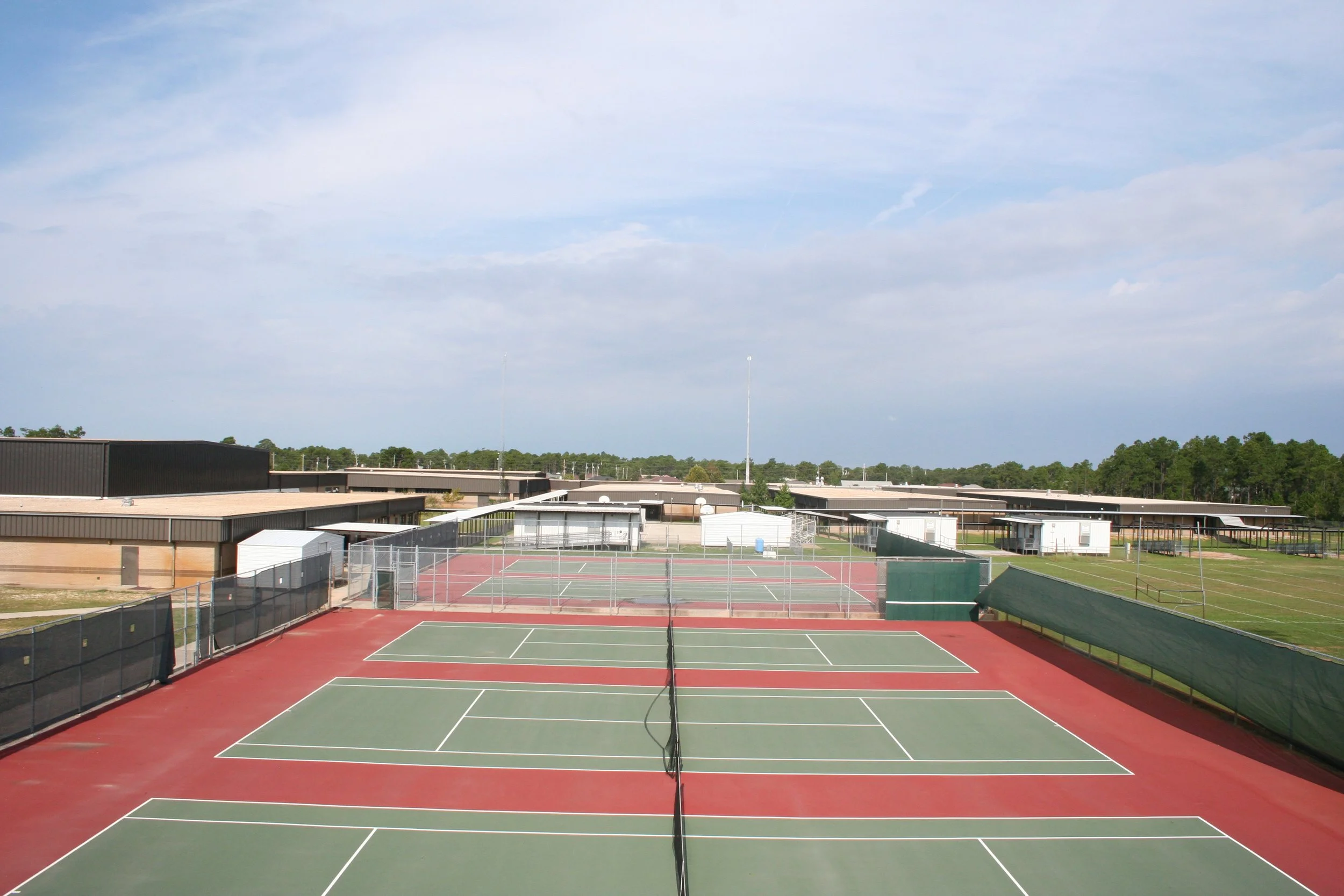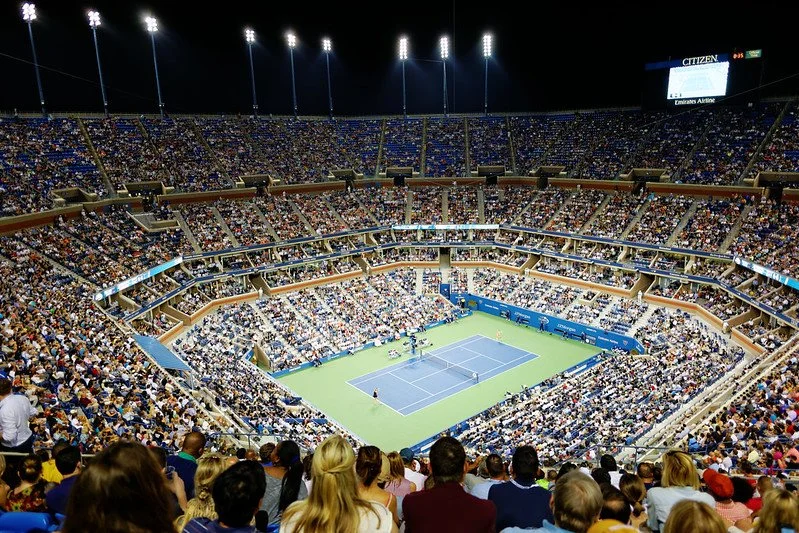Tennis is for everyone
By Margaret Dalbey | May 27, 2025
Navarre High School Tennis Courts photo by j2003af
Spring has sprung, which means many Baltimore City students are hitting the courts to try out for tennis teams.
The sport can feel overwhelming or complicated for people just starting to play or watch. But students who play for city schools say it’s never too late to get into tennis. It can be a form of entertainment, a social gathering, maybe even something to take your mind off the stress of school for a few minutes (or even hours!).
But unfortunately, tennis is not accessible to many teens because of its complex nature and the time, energy, and research required to understand how to play the game.
That’s why I turned to the experts. I talked to Alia Maroud, 17, and Elias Paragios, 15, who both play tennis for Baltimore City College (City), and Amir Muhammad, 17, who has played for Baltimore Polytechnic Institute (Poly).
They told me about their relationship with tennis and how it has shaped their high school experience.
Name: Alia Maroud
Age: 17
School she plays for: Baltimore City College
Advice: Despite feeling nervous to try out for the BCC team and having no prior experience, Alia took the risk and she couldn’t be more grateful that she did. Not only has she learned a tremendous amount from Coach Tate, head of the City team, but it’s also become an opportunity to hang out with friends that she’s made on the team and push her limits!
“Playing tennis on the City team really made me a lot more extroverted. It gave me a lot of opportunities to talk to people that I don't think I would have interacted with, or established friendly relationships with that I have now. I think we would have been more of strangers. Playing tennis also gives me a challenge, and something to do and focus on besides my studies.” Not to mention the added perk of leaving class early for games that she was so passionate about!
She also has strong opinions about stretching: “Any type of calisthenics is your number one best friend! You 100% want to stretch when it comes to tennis. You're going to be moving a lot.”
Name: Amir Muhammad
Age: 17
School he played for: Baltimore Polytechnic Institute
Advice: From messing around with a racket with his uncle at 6 to playing tennis in high school, Amir knows the ins and outs of learning the game. He says that it’s most important to “go on youtube and search up how to play the game – don’t embarrass yourself” but also that “getting the hang of it” is part of the experience, everyone felt stupid learning to play at some point.
Name: Elias Paragios
Age: 15
School he plays for: Baltimore City College
Advice: Starting at the young age of 9, Elias just picked up a racket one day, not even a tennis racket, and started hitting the ball around. He swears that tennis in high school is not stressful, in fact it’s allowed him to connect with so many people, even when facing tough matchups.
Elias shares about the drills and exercises that the tennis team does that you might want to try out: “we do drills during practice, where you get to where you try and hit a pyramid, and hit specific areas.” They also do fast sequencing drills: “practice the forehand, then you hit it back and then you come in for a volley [a ball right over the net].” In terms of stretching, “we do lunges which help with getting into the ball and we learn how to do split steps using the ladder [that lays on the ground].”
His advice is to connect with people as you meet them and don’t worry about making silly errors with your forehand or your backhand!
Everyone: A common theme among all the players was that looking up videos and researching a little bit about the game is extremely helpful, especially for serving, aiming, and the positioning of your hands on the racket.
Where to Start
Volunteer RHS tennis team instructors Laura McCutcheon and Shannan Chan play a tennis ball agility drill with youth participants Abby Harrison, Shawna Chan and Lydia Meusch. Photo by Rob Barth
Are there places to practice? Although recreation spaces are somewhat hard to come by in Baltimore, there are a few free spots that are open to players at all levels. Clifton Park in Northeast Baltimore has eleven courts that were resurfaced in 2020, with lighting and surrounding woodland, so you can practice at night with a view.
If your school has tennis courts, don’t be afraid to stop after school just to hit the ball around. Alia encourages just going to a tennis court and playing with the people there, or you could bring some friends!
Looking for somewhere to train? Orchard Tennis and Fitness Club in Towson offers private lessons for both adults and juniors on clay courts, taught by pros. You can even rent out the courts.
There is also the Twin Lakes Racquet Club, located in Windsor Mill, that offers clinics and group lessons to improve your tennis skills! Group lessons may be useful if you are just starting out and want to pick up some knowledge without having all the attention on you.
What if I want to watch? Watching tennis is a wonderful introduction to ease your way into understanding the sport; Elias got hooked on tennis just from stumbling upon the Australian Open on TV one night! My interviewees recommend keeping an eye on these players:
Carlos Alcaraz, 21, is a Spanish player who made his ATP (professional tennis tournament circuit) debut when he was only 15 and went on to win several titles. He was the youngest man to win the US Open in 2022 and was the youngest to finish the year ranked world number one. He is still playing strongly today!
Ben Shelton, 22, is an American player who competed at the junior championship level in college for the University of Florida and made it to the semi-finals of several major tournaments. He is improving each year and aims for the Major titles and the glory that comes with them!
Learner Tien, 19, is an American player who rose to fame after winning an epic battle with Medvedev (tennis legend) in the Australian Open. His mental game is incredibly impressive. Be on the lookout for future matches!
Coco Gauff, 21, is an American player who shocked the world at only 15 years old by defeating Venus Williams at Wimbledon. She plays both doubles and singles, reaching her highest world number 1 and 2, respectively, at different points in her career. Gauff’s career is far from over as she progresses every day and aspires to be the number one!
As of May 2025, the world number one is Aryna Sabalenka for women’s and the number one for men’s is Jannik Sinner, two veterans of the game.
Elias, a tennis fanatic, scours the lower levels of the tennis world, like the Challenger Tour, and searches for new players to look out for. He appreciates and recommends watching João Fonseca, 18, a new star rising on the ATP Tour (from the junior level) with a rabid fan base. He’s also the current number one male Brazilian player. Elias recommends searching for tournaments held in Washington, D.C. during the summer to catch a glimpse of these players!
Elias is also in awe of Alexandra Eala, 19, and current doubles partner to Gauff, and Andreeva, 18, for their recent wild upsets against very high-ranking players.
There are also 4 Grand Slam tournaments each year, called the Majors, where the biggest stars compete for glory: the Australian Open, Roland Garros (French Open), Wimbledon (in England), and the US Open. These tournaments are spread out throughout the season and widely televised, so tuning in is recommended!
The 2014 US Open is a tennis tournament played on the outdoor hard courts. Photo by Michael Vadon
What are the basics for scoring? According to The Sporting News, a tennis match is over once one player wins two out of three sets for women, or three out of five sets for men. A set is played until one person wins six games, but they have to win by two, or they enter a tie-breaking round.
To win a game, players have to score four points (which are counted by 15, 30, 40, and “game point”). If both players get to 40, they enter a “deuce,” in which one player has to score two points in a row to win. Players can score points in a lot of different ways, but the key detail is that scoring happens when the opponent doesn’t return the ball.
What equipment do I need? According to my interviewees, not a lot is needed to start. A cheap racket and some tennis balls are all you need to at least start playing. They recommend going online to Tennis Warehouse or Tennis Point to get long-lasting tennis shoes with a good layer of rubber because not every tennis shoe is for playing tennis, despite what you might think. Elias also recommends investing in some grips to put on the racke,t which increases stability and helps get over the awkwardness of holding it.
Just Start! / Research it?
The most important thing I’ve learned while researching and writing this is to just start! Tennis might feel daunting or embarrassing, but every person I’ve spoken to has said so too.
If you want to play tennis, don’t go to pickleball! “No matter how much TV or how much it's being publicized right now, don’t go to pickleball,” says Elias.
According to Alia, Elias, and Amir, it's never too late to start playing tennis. If you’re in high school, you can start playing as a freshman, sophomore, junior, or even a senior. Out of high school, the sky’s the limit! As Alia put it, “Tennis is literally for everybody.”



